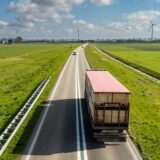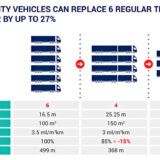
EU sets strictest targets cutting truck emissions 45% by 2030
European Union officials concluded terms on the world’s most ambitious carbon emissions reduction regime targeting new heavy trucks and buses.
The provisional political agreement on January 18 between appointed European Parliament and Council negotiators requires formal approval. But it indicates high confidence around enacting the legislation given alignment on sweeping proposals.
The European Commission welcomed the deal strengthening standards it introduced last February for reducing CO2 outputs from heavy-duty vehicles (HDVs) like lorries, coaches and trailers sold in the EU.
The new targets seek cuts of 45% by 2030, 65% by 2035 and 90% by 2040 off a 2019 baseline. They also expand the number of commercial vehicle categories facing mandates to practically all configurations beyond niche exclusions like military fleets.
Urban buses require deeper short-term emissions slashing, requiring 90% reductions by the end of this decade before reaching 100% zero-emission status from 2035. Specific goals also apply for permitted trailer pollution aligned to functionality.
The Commission views the agreement sending an unequivocal signal to vehicle manufacturers, operators and buyers on steering investments into innovative zero-emissions platforms. It also aims to spur amplified development of supporting recharging and refueling infrastructure considered critical to enabling adoption.
Next steps entail formal ratification from Parliament and the Council representing member state interests. The resulting enacted legislation then publishes in the Official Journal codifying the HDV emissions program within EU law.
A review clause requires the Commission gauging implementation effectiveness by 2027 encompassing areas like expanding scope to lighter vans and registering vehicles utilising carbon neutral fuels conforming to climate neutrality. Evaluating emissions accounting improvements and transmission efficiency incentives also falls under mandated follow-up assessments.
The initial proposal formed the first update to initial heavy commercial vehicle CO2 rules established in 2019 given the segment’s responsibility for more than a quarter of all European road transport emissions. Slow replacement cycles increase urgency around new sales meeting targets that then filter down fleets long-term.
Trade bodies indicate the approved new truck and bus carbon cutting goals through 2030 and 2035 represent the most ambitious globally. However, they argue vital public electric charging and hydrogen infrastructure remains deficient amid already strained production capabilities.
In a statement, European Automobile Manufacturers’ Association (ACEA) Director Sigrid de Vries said manufacturers fully support sustainability ambitions but called the CO2 mandate timelines “extremely challenging.”
ACEA analysis indicates achieving a 30% emissions cut by 2030 requires at least 400,000 in-service zero-emissions trucks and buses, plus thousands of megawatt fast-charging stations and hydrogen pumps regionwide.
De Vries explained the industry relies on fleet operator demand and profitability around costly new vehicles that allows replacing older models. Despite manufacturer investments in next-generation offerings, “enabling conditions” must accelerate to incentivise sufficient adoption rates meeting goals.
These include comprehensive carbon pricing mechanisms applied evenly across transport modes along with purchase incentives that help operators mitigate higher upfront costs of battery electric and hydrogen-powered trucks.
Analysts describe commercial road transport decarbonisation as inescapable for Europe meeting mandated economy-wide emission cuts. They expect other regions to replicate methodologies given international ownership linkages in the global truck market.
Continued innovation incentives also secure first-mover advantages for EU technology firms around efficiency and sustainability hallmarks. However, some nations like China and Japan lead targeted areas as competition intensifies on delivering green solutions.
.jpg)










